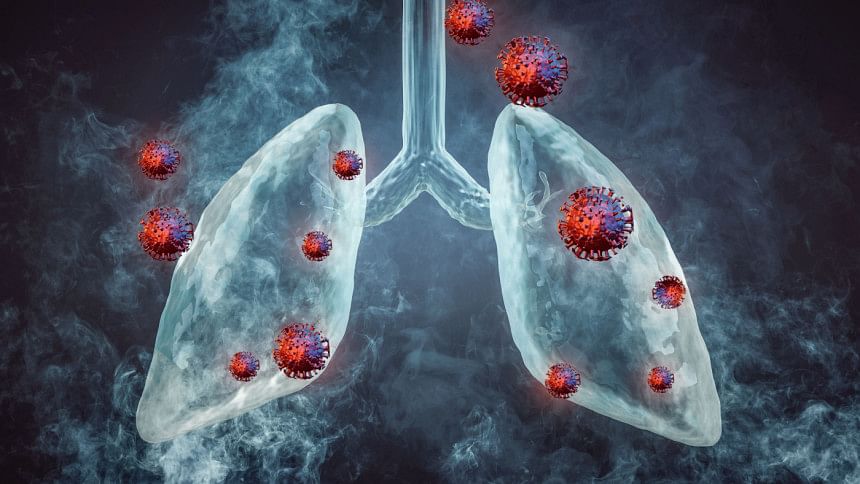Lung cancer symptoms: what you must know

Lung cancer often develops without showing any symptoms in its early stages. The lungs do not have many nerve endings, so a tumour can grow without causing noticeable pain. This makes it difficult for many people to detect lung cancer until it has advanced and spread to other parts of the body.
When lung cancer symptoms do appear, they may include:
• A chronic, raspy cough, sometimes with blood-streaked mucus
• Changes in a long-standing cough
• Recurring respiratory infections, like bronchitis or pneumonia
• Shortness of breath that worsens over time
• Wheezing, lasting chest pain, hoarseness, and trouble swallowing
• Shoulder pain
These symptoms typically occur when a tumour blocks airways or cancer spreads to nearby tissues.
Symptoms of early-stage lung cancer:
At Stage I, lung cancer is usually symptomless. It is often caught through screenings rather than the patient noticing symptoms. However, some signs may include a persistent new cough, coughing up blood or mucus, shortness of breath, chest pain, or frequent infections like bronchitis or pneumonia.
Symptoms of advanced lung cancer:
In Stage IV, when the cancer spreads to more areas of the lungs or other parts of the body, additional symptoms may develop, such as:
• Fatigue and weakness
• Loss of appetite and weight loss
• Headaches, numbness, or seizures if the cancer has reached the brain
Other uncommon symptoms:
Some symptoms of lung cancer affect parts of the body not directly connected to the lungs, such as:
• Clubbing of the fingers, where the nails curve and fingers appear larger
• High calcium levels in the blood, leading to stomach upset, thirst, frequent urination, or confusion
• Horner syndrome, which causes a drooping eyelid, a smaller pupil, and less sweating on one side of the face
• Swelling in the face, neck, or arms due to restricted blood flow
Skin-related symptoms
Lung cancer can also cause certain skin issues, such as jaundice (yellowing of the skin and eyes) or easy bruising due to interference with adrenal glands.
Lung cancer is the leading cause of cancer deaths globally, but the rates have been decreasing. However, the decline is not as significant among younger women. This has raised questions among experts, with genetic factors possibly playing a role. Historically, lung cancer has been associated with older men who smoke, so doctors may not immediately suspect the disease when a nonsmoking young woman presents with symptoms like a persistent cough or recurring respiratory infections.
Types of lung cancer and their symptoms:
There are two main types of lung cancer: non-small cell lung cancer (NSCLC) and small cell lung cancer (SCLC). NSCLC is more common, making up about 85% of cases. It has three subtypes:
1. Adenocarcinoma: More common in women and nonsmokers, usually found in the outer areas of the lungs.
2. Squamous cell carcinoma: Typically forms in the central part of the lungs near the airways.
3. Large cell carcinoma: Can develop anywhere in the lungs and tends to grow faster.
SCLC, while less common, spreads quickly and is more strongly linked to smoking. It is also more likely to cause symptoms like bone pain, confusion, seizures, and paralysis.
Both NSCLC and SCLC share many symptoms, such as coughing, chest pain, wheezing, and hoarseness. SCLC is more likely to cause hypercalcemia (high calcium levels) and problems with the adrenal glands.
When to see a doctor:
If you experience persistent coughing, coughing up blood, frequent respiratory infections, or wheezing, it is important to see a doctor. Additionally, sudden shortness of breath, coughing up large amounts of blood, chest pain that does not go away, sudden vision problems, or weakness should prompt an immediate visit to the emergency room.
Takeaways:
Lung cancer often goes unnoticed in its early stages due to the lack of symptoms. Common signs include a persistent cough, chest pain, and recurring infections. It is important to consult a doctor if you are concerned, as early detection improves the chances of successful treatment.
While lung cancer is a serious diagnosis, treatments are improving, and survival rates are increasing, particularly when the disease is caught early.

 For all latest news, follow The Daily Star's Google News channel.
For all latest news, follow The Daily Star's Google News channel. 








Comments